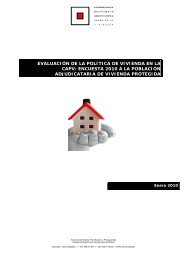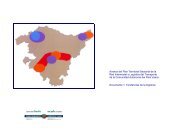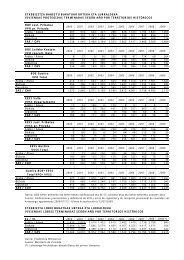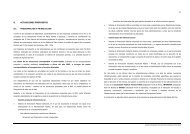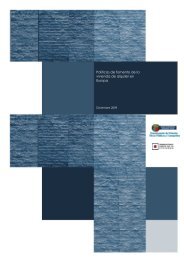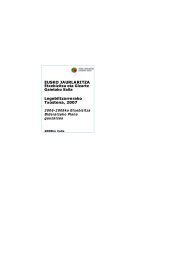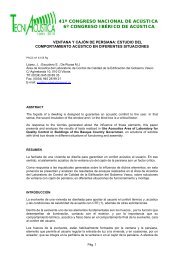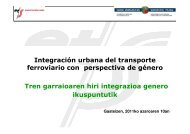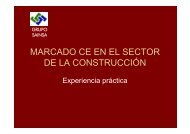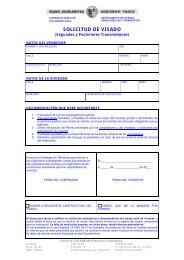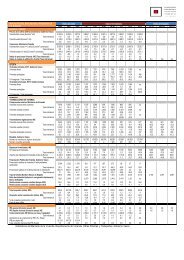2. análisis de la situación actual de la red viaria - Garraioak
2. análisis de la situación actual de la red viaria - Garraioak
2. análisis de la situación actual de la red viaria - Garraioak
Create successful ePaper yourself
Turn your PDF publications into a flip-book with our unique Google optimized e-Paper software.
INTERSECCIONES SEGÚN TIPOLOGÍA EN LAS CARRETERAS DE LA RED OBJETO<br />
Carretera (2) Nº Intersecciones tipo “A” Nº Intersecciones tipo “B”<br />
Red <strong>de</strong> Interés Preferente<br />
N-I 6 6<br />
N-102 0 2<br />
N-104 4 3<br />
N-121-A 1 0<br />
Red Básica<br />
N-124 4 2<br />
N-240 18 13<br />
N-624 0 1<br />
N-629 5 0<br />
N-634 55 40<br />
N-636 17 12<br />
N-638 6 2<br />
N-639 5 6<br />
A-124 22 3<br />
A-132 13 10<br />
A-623 2 0<br />
A-624 19 6<br />
A-625 7 1<br />
A-627 8 2<br />
BI-604 0 2<br />
BI-623 6 6<br />
BI-624 1 0<br />
BI-625 10 8<br />
BI-630 18 0<br />
BI-631 22 5<br />
BI-633 43 19<br />
BI-635 30 2<br />
BI-636 5 7<br />
BI-637 0 3<br />
GI-131 9 10<br />
GI-627 6 12<br />
GI-631 26 12<br />
GI-638 8 3<br />
Total 376 198<br />
Fuente: E<strong>la</strong>boración propia<br />
2<br />
Las carreteras N-622, N-633, N-637, N-644 y BI-638 no figuran en <strong>la</strong> presente re<strong>la</strong>ción ya que no presentan intersecciones a nivel.<br />
Por otra parte, no existen datos <strong>de</strong> <strong>la</strong> carretera BI-639.<br />
Se observa que p<strong>red</strong>ominan <strong>la</strong>s intersecciones en <strong>la</strong>s que no está canalizado el giro a <strong>la</strong> izquierda; es <strong>de</strong>cir,<br />
el vehículo en caso <strong>de</strong> querer hacer esta maniobra interrumpe <strong>la</strong> circu<strong>la</strong>ción en <strong>la</strong> vía principal. Respecto al<br />
total <strong>de</strong> intersecciones a nivel (574), <strong>la</strong>s incluidas en este grupo suponen el 65,5%.<br />
Por el contrario, <strong>la</strong>s intersecciones que permiten una mayor flui<strong>de</strong>z <strong>de</strong>l tráfico, ya que o bien disponen <strong>de</strong><br />
carril <strong>de</strong> espera en el tronco o raquetas <strong>de</strong> giro o bien se resuelven mediante glorietas, son menos<br />
numerosas que <strong>la</strong>s anteriores y representan el 34,5% <strong>de</strong>l total <strong>de</strong> intersecciones existentes en <strong>la</strong> ROP.<br />
Se adjuntan seguidamente gráficos expresivos <strong>de</strong> <strong>la</strong> tipología <strong>de</strong> <strong>la</strong>s intersecciones existentes en <strong>la</strong> Red<br />
Objeto según <strong>la</strong> c<strong>la</strong>sificación <strong>de</strong> <strong>la</strong> <strong>red</strong>.<br />
INTERSECCIONES SEGÚN TIPOLOGÍA EN LA RED DE INTERÉS PREFERENTE<br />
60<br />
50<br />
40<br />
30<br />
20<br />
10<br />
0<br />
Intersecciones tipo A Intersecciones tipo B<br />
Fuente: E<strong>la</strong>boración propia<br />
INTERSECCIONES SEGÚN TIPOLOGÍA EN LA RED BÁSICA<br />
45<br />
40<br />
35<br />
30<br />
25<br />
20<br />
15<br />
10<br />
5<br />
0<br />
Intersecciones tipo A Intersecciones tipo B<br />
Fuente: E<strong>la</strong>boración propia<br />
116<br />
Revisión <strong>de</strong>l Segundo P<strong>la</strong>n General <strong>de</strong> Carreteras <strong>de</strong>l País Vasco



